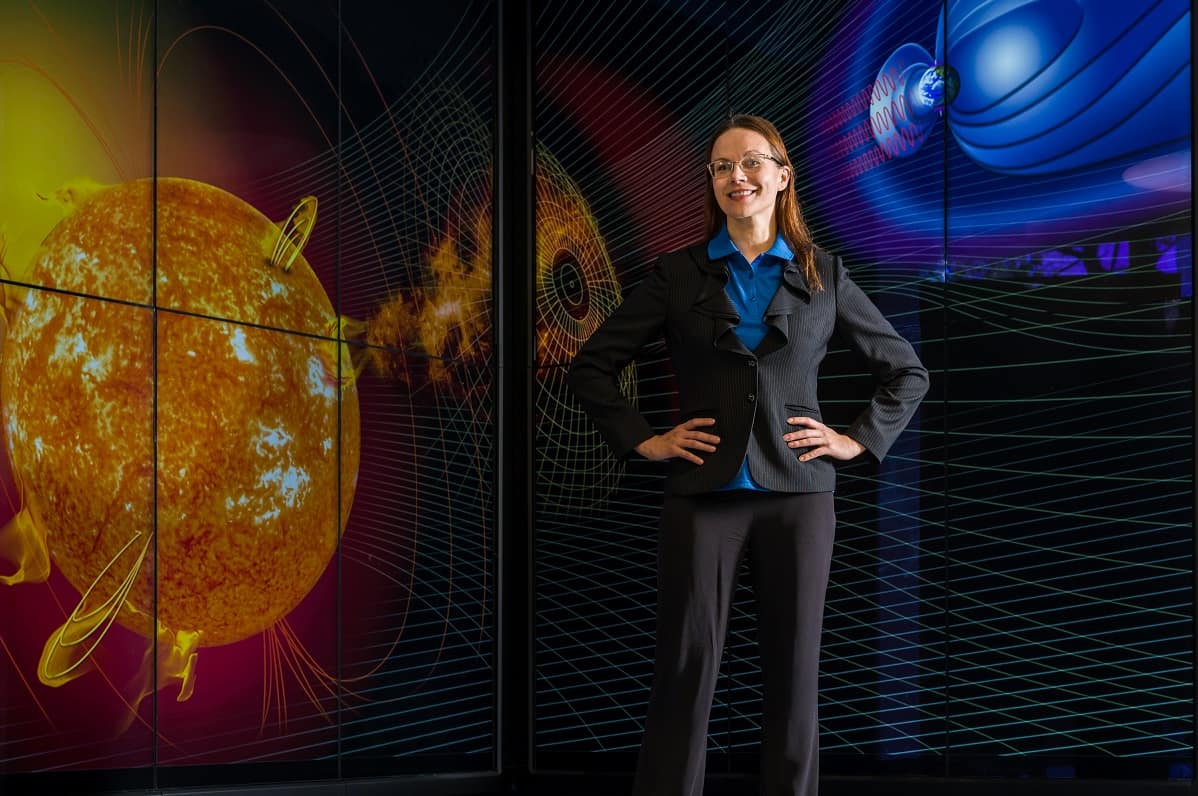Heat Wave: ERAU Researchers Discover How Solar Winds Heat Ions Across Earth

Embry-Riddle researchers’ discovery of how solar wind heats up ions across Earth’s magnetic boundary points to bigger questions about the nature of the sun and could advance research into clean nuclear power.
A discovery made by Embry-Riddle Aeronautical University researchers about space plasma might help answer one of the burning questions in solar physics: How is the sun’s corona heated? It could also someday reveal a pathway tomaking clean nuclear fusion power a reality. Katariina Nykyri, a physics professor, and Tommy Moore, a doctoral student — both researchers at Embry-Riddle’s Center for Space and AtmosphericResearch (CSAR) — published their findings on how solar wind transfers energy across Earth’s magnetic field barrier in the September 2016 issue of Nature Physics. Together with Andy Dimmock from Aalto University in Espoo, Finland, they dug deep into sensor data from the European Space Agency’s Cluster satellites to discover how solar wind interacting with Earth’s magnetic field is responsible for heating particles in Earth’s magnetosphere.
PLASMA POWER
Solar wind — a continuous flow of plasma comprised of mostly electrons and protons — streams away from the sun at speeds up to 1 million miles per hour, hurtling its way toward Earth and other objects in the solar system. Embedded in that solar wind are elements of the sun’s magnetic field that interact with Earth’s magnetosphere, a boundary layer created by the magnetic field around the Earth that is impenetrable to solar wind.
“The Earth’s magnetic field acts as a shield from these particles. Without our magnetic field, they would strip off our atmosphere,” Moore says. “The sun is a source of energy, but particles can’t cross straight over. We’re looking to see how this energy is transported into the inner parts of the Earth’s magnetosphere.”
A key to answering that question lies within a common phenomenon known as the Kelvin-Helmholtz (KH) instability. As the sun’s plasma flows alongside the Earth’s relatively stationary plasma, the magnetic field boundary begins to ripple, forming waves measuring approximately 36,000 km from peak to peak.
These enormous waves made up of the Earth’s plasma and solar plasma then curl and spill over each other — similar to the way ocean waves act as wind moves over them — creating a turbulent mix of charged particles in a predictable KH instability pattern. The pattern can be seen anytime two different fluids flow past one another at different speeds — certain cloud formations, for example, and even in daily office life.
“It’s like pouring cream into a cup of coffee,” Moore explains. “The cream is thicker and moving faster than the coffee. The boundary between the two is unstable, and that’s where a swirl starts to form. In this case, coffee is Earth’s hot plasma and the creamer is solar wind plasma.”
The presence of these huge waves has been correlated with increased temperatures of the plasma ions in Earth’s magnetosphere. What was not understood prior to this discovery is how the energy from these huge waves is able to directly heat the plasma at the boundary layer.

Tommy Moore, doctoral student
THE HOT DISCOVERY
This seemingly straightforward question has a surprisingly complex answer, because plasmas don’t interact with each other in the same way as other states of matter. It’s not obvious that plasma interactions would generate heat because they don’t crash together in the traditional sense.
“When a truck collides with a small car, it creates heat as both vehicles absorb energy from the impact. Space plasma is actually collision-less. You don’t have particle-to particle collisions like you see in classical mechanics. Here we have this huge velocity shear and all this kinetic energy, but how does this kinetic energy become heat?” Nykyri says. “These particles aren’t colliding directly with one another; they’re interacting with electromagnetic waves.”
It turns out that these KH waves, which are too big to directly heat plasma particles, generate smaller waves of their own, with wavelengths on the scale of plasma ions (200 to 2,000 km). These waves, which Embry-Riddle researchers discovered radiating from the low pressure center of the KH instability, speed up the plasma particles in the Earth’s magnetosphere by synching up with their orbits and pushing them over and over again as they circle their magnetic field lines. In the world of particle physics, a faster moving ion is a hotter ion. “The ions can get in resonance with the right kind of waves, and these waves then can heat them up,” Nykyri says.
That transfer of energy from the large KH waves to the much smaller, ion-scale waves inside the low-pressure center of the KH vortex is the crux of the discovery, because it explains to an important degree how the ions in the Earth’s magnetosphere are heated.
“What we showed is that we found ion-scale waves in the center of a KH wave vortex that had sufficient energy to heat the cold ion population,” Moore says. These ion-scale waves are created by an unstable distribution of ions, and the specific mechanism for how these distributions are created is currently under investigation by Nykyri and her collaborators.
UNLOCKING THE MYSTERIES OF THE SUN
The discovery by Moore, Nykyri and Dimmock has potential impacts for developing nuclear fusion reactors, a cleaner alternative to nuclear fission. Nuclear fusion creates energy the same way the sun does: by smashing small hydrogen atoms together. The only exhaust is helium.
But fusion reactions are challenging to contain. Prototype reactors currently use magnetic fields around the superheated plasma, Nykyri says, but they use more energy than they generate. A lot of energy is lost because plasma particles stray away from the area being heated.
“Fusion systems can’t reach critical temperatures because of this transport problem. But if we are able to put an appropriate boundary layer there with the right density gradient, we can make it so the energy transport always occurs toward the center. This mechanism not only prevents plasma from transporting away, it could also provide additional heat to the center.”
These findings could also propel continued research on one of the biggest mysteries in space: “The holy grail of all of space physics is, ‘What heats the solar corona?’” Nykyri says.
At the sun’s core, the temperature is millions of kelvins, but cools as you move from the center to about 6,000 kelvins at the surface. “When you come to the corona, boom! It heats up again to several million kelvin. This is not understood,” Nykyri says. “But what we know about the sun is that you have shear flows. It’s possible the same mechanism heating ions in Earth’s magnetosphere is occurring in the solar corona.”

 Alan Marcos Pinto Cesar
Alan Marcos Pinto Cesar